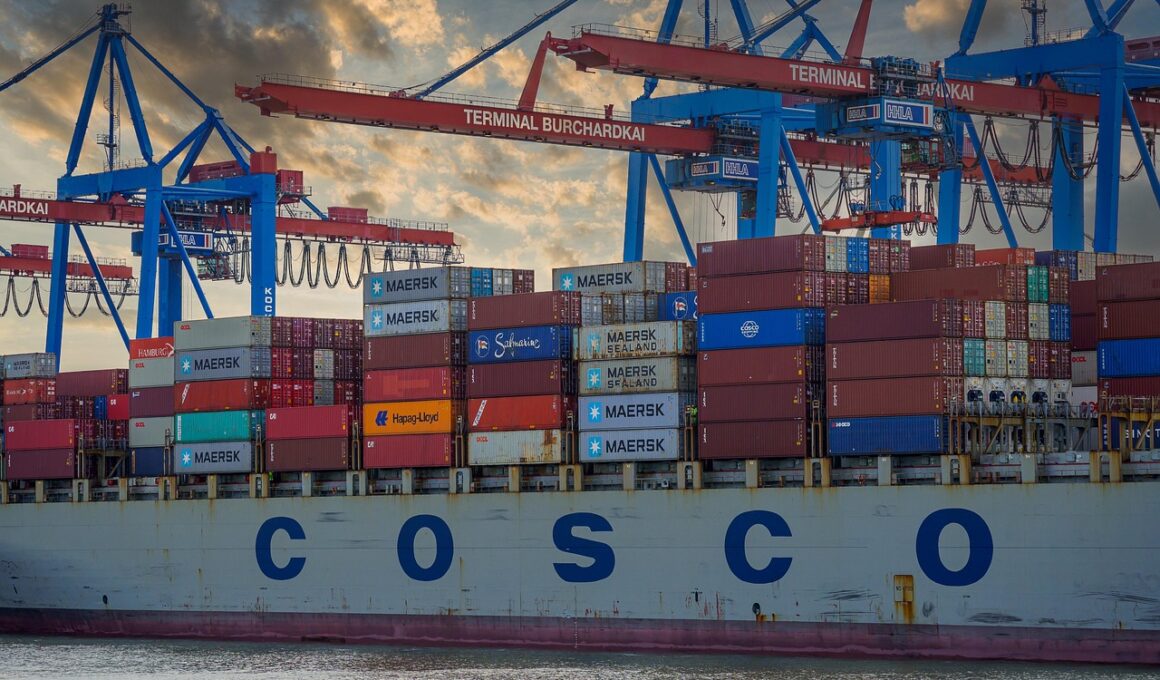Analyzing Asia-Pacific’s Position in Global Supply Chains
The Asia-Pacific region plays an indispensable role in global supply chains, impacting various sectors, including technology, automotive, and agriculture. With a remarkable range of economies, from highly developed nations like Japan and South Korea to emerging markets such as Vietnam and Indonesia, the region is a diverse landscape for investment and trade. Factors such as fluctuating labor costs, advancements in technology, and evolving trade policies considerably influence how businesses operate within these economies. Additionally, the region is characterized by its strategic location, facilitating swift access to key markets in North America and Europe. The mix of competitive advantages presents numerous opportunities for companies seeking to maximize efficiency. Furthermore, geopolitical tensions, particularly between major players like China and the United States, often affect supply chain decisions dramatically. Businesses must continuously evaluate risk and adapt strategies to navigate this complex environment. Recent events, including the COVID-19 pandemic, have accelerated this reevaluation process, prompting firms to reconsider just-in-time supply strategies, diversify supply sources, and strengthen local production capacities. Understanding these dynamics is essential for firms aiming to thrive in the Asia-Pacific context.
Shifts in Supply Chain Dynamics
As the Asia-Pacific region encompasses vast and varied markets, shifts in supply chain dynamics profoundly impact both regional and global trade flows. The increasing importance of sustainability practices has compelled companies to reassess their operational frameworks. Environmental regulations and consumer demand for more eco-friendly products have led businesses to seek greener alternatives in their supply chains. Furthermore, technological advancements such as artificial intelligence and blockchain are reshaping logistics and inventory management, allowing for greater transparency and efficiency. The elevation of e-commerce has also transformed supply chains, demanding faster delivery models and enhanced customer service levels. Companies are striving to create scalable and agile supply chains to adapt quickly to market changes while maintaining cost efficiencies. Automation and robotics in warehouses are essential trends contributing to increased productivity. However, the potential for cyber threats introduces new challenges requiring robust cybersecurity measures. Consequently, companies must balance innovation with risk management to ensure resilience. This strategic focus is crucial as firms aim to leverage the region’s rich potential while safeguarding against vulnerabilities inherent in modern supply chain systems.
Challenges faced in the Asia-Pacific markets necessitate a comprehensive understanding of local contexts and industry nuances. Different countries exhibit unique regulatory landscapes that affect how businesses operate. Firms must navigate these challenges effectively to maintain competitiveness. Diverse consumer preferences in the region can complicate product strategies, requiring tailored approaches to meet local demands. Additionally, supply chain disruptions caused by natural disasters or political instability are recurring issues that must be planned for adequately. Infrastructure development varies widely, with urban areas often having sophisticated logistics frameworks, while rural regions may lack essential transportation links. Moreover, competition from well-established local enterprises can pose significant challenges to foreign entrants who may underestimate local market complexities. Therefore, understanding cultural nuances and building relationships with local partners are critical for success. Workforce dynamics also play a vital role, with varying skill levels across the region influencing operational capabilities. Companies increasingly consider hiring locally to harness regional talent effectively. Ultimately, a strategic framework that incorporates risk mitigation, local insights, and sustainable practices is essential for achieving long-term supply chain stability in Asia-Pacific.
The Role of Technology in Supply Chain Enhancement
Technology is the backbone of modern supply chain enhancements in the Asia-Pacific region. Various technologies are rapidly evolving to address the increasing demands for efficiency and transparency. Innovations such as Internet of Things (IoT) devices enable real-time monitoring of goods throughout the supply network. This capability allows companies to respond proactively to potential disruptions and optimize inventory management. Moreover, data analytics has become a game changer, allowing organizations to glean insights from vast datasets and make informed decisions. Robotics is also transforming warehouses, improving order fulfillment speeds while reducing operational costs. Cloud-based platforms promote better collaboration between suppliers, manufacturers, and customers, enhancing visibility and communication. Companies are leveraging predictive analytics to anticipate demand fluctuations and adjust production strategies accordingly. Blockchain technology holds the potential to revolutionize supply chain management by ensuring authenticity and traceability of products, thereby mitigating fraud risks. As technology continues to evolve, organizations embracing these advancements stand to gain significant competitive advantages. Investing in technological infrastructure is not merely an option but a necessity for businesses aspiring to lead in the complex Asia-Pacific supply chain landscape.
Trade agreements and geopolitical factors significantly influence the dynamics of Asia-Pacific supply chains. Numerous agreements exist, aiming to reduce tariffs and foster trade cooperation among member nations. The Regional Comprehensive Economic Partnership (RCEP) highlights this trend, encompassing major economies and aiming to streamline trade processes across the region. While such agreements offer opportunities for growth, the balancing act between geopolitical interests can complicate trade relations. The shifts in alliances, especially amid rising tensions between the United States and China, impact how firms position themselves within the supply chain landscape. Nations are increasingly investing in regional partnerships to mitigate reliance on single-source countries and enhance self-sufficiency. This strategy not only reduces risks but also strengthens regional economies by developing local industries. Furthermore, varying regulatory environments makes understanding compliance issues imperative for international businesses. Navigating these trade networks requires agility and awareness of changes in trade policies. Additionally, firms must continuously engage with local governments to adapt to evolving regulations. Ultimately, a strategic approach to trade partnerships is vital for companies to maximize their potential in the dynamically evolving Asia-Pacific markets.
Future Trends and Considerations
Looking ahead, companies in the Asia-Pacific markets must adapt to emerging trends shaping global supply chains. The shift towards digitalization will continue to dominate discussions as firms seek to leverage technology for enhanced efficiency and resiliency. Developing sustainable supply chains will be another key focus, as consumer awareness regarding environmental impact rises. Companies that invest in sustainable practices may reap long-term benefits, including customer loyalty and operational efficiencies. Supply chain diversification will remain critical, with firms working to avoid over-reliance on specific markets or suppliers. This diversification strategy is vital in mitigating risks associated with potential disruptions, whether economic, political, or natural. Additionally, the ongoing impact of global economic uncertainties necessitates continuous adaptation to changing market conditions. Resilience in supply chains will become paramount as companies enhance their ability to respond swiftly to untimely disruptions. Workforce development will also be a priority, as organizations aim to equip employees with skills to navigate technological advancements. Ultimately, fostering a culture of innovation and adaptability will be essential in maintaining competitive advantages in the complex Asia-Pacific supply chain ecosystem.
In summary, the Asia-Pacific region holds a significant and evolving position within global supply chains, characterized by rapid changes in technology, consumer demands, and geopolitical landscapes. Companies operating in this vibrant space must navigate a complex array of challenges and opportunities while keeping an eye on emerging trends. The region’s diversity presents unique market dynamics requiring tailored strategies to meet local demands and ensure compliance with various regulations. Furthermore, the rapid digital transformation of supply chains emphasizes the necessity for firms to continuously invest in technological advancements to remain competitive. Building sustainable and resilient supply chains will undoubtedly enhance brand reputations and foster long-term customer loyalty. Lastly, companies ought to prioritize strategic partnerships with local players to understand cultural nuances effectively. Resilience, adaptability, and a commitment to innovation will be key drivers for success. As firms continue evolving within this dynamic environment, leveraging insights and maintaining flexibility will define their ability to thrive in the Asia-Pacific markets. By embracing these principles, organizations can effectively position themselves for sustainable growth and competitive advantage in a constantly shifting global landscape.
Ultimately, analyzing Asia-Pacific’s role in global supply chains uncovers a landscape rich with opportunities and challenges. For businesses to succeed, they must comprehensively evaluate the region’s vast complexities, incorporating technology, sustainability, and cultural considerations into their strategic plans. Embracing a proactive stance toward risk management and investing in innovation will be crucial in navigating this evolving landscape. As the world becomes increasingly interconnected, Asia-Pacific’s importance in shaping global supply chains will only grow. Companies that recognize this potential and adapt their strategies accordingly will be better positioned for transformative success. The call for resilience and flexibility within supply chains has never been more pressing, making it essential for organizations to rethink and refine their approaches to doing business in the Asia-Pacific region. Engaging local expertise and fostering collaborative networks across industries will facilitate a deeper understanding of market dynamics. As businesses embrace the realities of global supply chain management, they will not only enhance their operational efficiency but also contribute to the overall growth of the Asia-Pacific economy. The forecast for the region remains positive, enabling companies to seize opportunities and thrive amid change.


